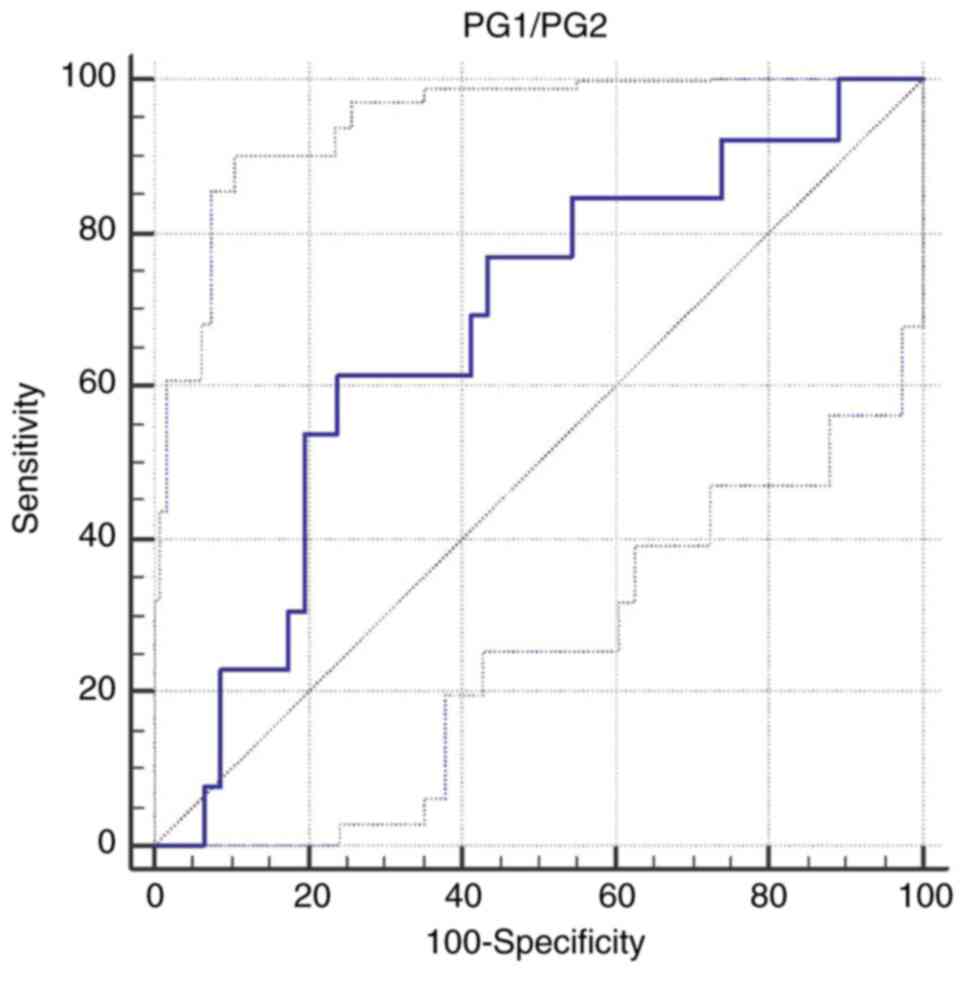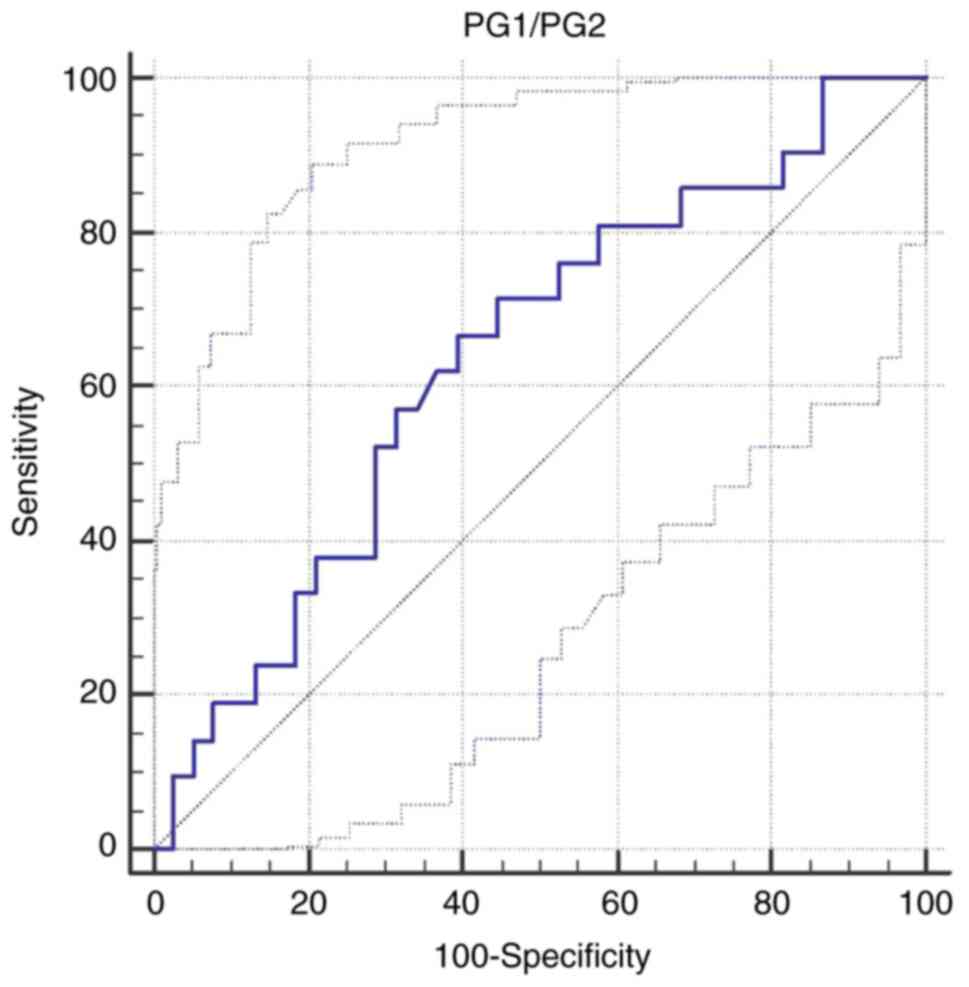|
1
|
Sipponen P, Kekki M, Haapakoski J, Ihamäki
T and Siurala M: Gastric cancer risk in chronic atrophic gastritis:
Statistical calculations of cross-sectional data. Int J Cancer.
35:173–177. 1985.PubMed/NCBI View Article : Google Scholar
|
|
2
|
Ohata H, Kitauchi S, Yoshimura N, Mugitani
K, Iwane M, Nakamura H, Yoshikawa A, Yanaoka K, Arii K, Tamai H, et
al: Progression of chronic atrophic gastritis associated with
Helicobacter pylori infection increases risk of gastric
cancer. Int J Cancer. 109:138–143. 2004.PubMed/NCBI View Article : Google Scholar
|
|
3
|
Varis K, Sipponen P, Laxén F, Samloff IM,
Huttunen JK, Taylor PR, Heinonen OP, Albanes D, Sande N, Virtamo J
and Härkönen M: Implications of serum pepsinogen I in early
endoscopic diagnosis of gastric cancer and dysplasia. Helsinki
Gastritis Study Group. Scand J Gastroenterol. 35:950–956.
2000.PubMed/NCBI View Article : Google Scholar
|
|
4
|
Correa P: A human model of gastric
carcinogenesis. Cancer Res. 48:3554–3560. 1988.PubMed/NCBI
|
|
5
|
de Vries AC, van Grieken NC, Looman CW,
Casparie MK, de Vries E, Meijer GA and Kuipers EJ: Gastric cancer
risk in patients with premalignant gastric lesions: A nationwide
cohort study in the Netherlands. Gastroenterology. 134:945–952.
2008.PubMed/NCBI View Article : Google Scholar
|
|
6
|
Song H, Ekheden IG, Zheng Z, Ericsson J,
Nyrén O and Ye W: Incidence of gastric cancer among patients with
gastric precancerous lesions: Observational cohort study in a low
risk western population. BMJ. 351(h3867)2015.PubMed/NCBI View Article : Google Scholar
|
|
7
|
Chapelle N, Péron M, Mosnier JF,
Quénéhervé L, Coron E, Bourget A, Cauchin E, Touchefeu Y and
Matysiak-Budnik T: Prevalence, characteristics and endoscopic
management of gastric premalignant lesions in France. Dig Dis.
38:286–292. 2020.PubMed/NCBI View Article : Google Scholar
|
|
8
|
den Hoed CM, Holster IL, Capelle LG, de
Vries AC, den Hartog B, Ter Borg F, Biermann K and Kuipers EJ:
Follow-up of premalignant lesions in patients at risk for
progression to gastric cancer. Endoscopy. 45:249–256.
2013.PubMed/NCBI View Article : Google Scholar
|
|
9
|
den Hollander WJ, Holster IL, den Hoed CM,
Capelle LG, Tang TJ, Anten MP, Prytz-Berset I, Witteman EM, Ter
Borg F, Hartog GD, et al: Surveillance of premalignant gastric
lesions: A multicentre prospective cohort study from low incidence
regions. Gut. 68:585–593. 2019.PubMed/NCBI View Article : Google Scholar
|
|
10
|
Dinis-Ribeiro M, Areia M, de Vries AC,
Marcos-Pinto R, Monteiro-Soares M, O'Connor A, Pereira C,
Pimentel-Nunes P, Correia R, Ensari A, et al: Management of
precancerous conditions and lesions in the stomach (MAPS):
Guideline from the European society of gastrointestinal endoscopy
(ESGE), European helicobacter study group (EHSG), European society
of pathology (ESP), and the sociedade portuguesa de endoscopia
digestiva (SPED). Endoscopy. 44:74–94. 2012.PubMed/NCBI View Article : Google Scholar
|
|
11
|
Malfertheiner P, Megraud F, O'Morain CA,
Gisbert JP, Kuipers EJ, Axon AT, Bazzoli F, Gasbarrini A, Atherton
J, Graham DY, et al: Management of Helicobacter pylori
infection the maastricht V/florence consensus report. Gut. 66:6–30.
2017.PubMed/NCBI View Article : Google Scholar
|
|
12
|
di Mario F and Cavallaro LG: Non-invasive
tests in gastric diseases. Dig Liver Dis. 40:523–530.
2008.PubMed/NCBI View Article : Google Scholar
|
|
13
|
Agréus L, Kuipers EJ, Kupcinskas L,
Malfertheiner P, Di Mario F, Leja M, Mahachai V, Yaron N, van Oijen
M, Perez Perez G, et al: Rationale in diagnosis and screening of
atrophic gastritis with stomach-specific plasma biomarkers. Scand J
Gastroenterol. 47:136–147. 2012.PubMed/NCBI View Article : Google Scholar
|
|
14
|
Di Mario F, Moussa AM, Caruana P, Merli R,
Cavallaro LG, Cavestro GM, Dal Bò N, Iori V, Pilotto A, Leandro G,
et al: ‘Serological biopsy’ in first-degree relatives of patients
with gastric cancer affected by Helicobacter pylori
infection. Scand J Gastroenterol. 38:1223–1227. 2003.PubMed/NCBI View Article : Google Scholar
|
|
15
|
Germaná B, Di Mario F, Cavallaro LG,
Moussa AM, Lecis P, Liatoupolou S, Comparato G, Carloni C, Bertiato
G, Battiestel M, et al: Clinical usefulness of serum pepsinogens I
and II, gastrin-17 and anti-Helicobacter pylori antibodies
in the management of dyspeptic patients in primary care. Dig Liver
Dis. 37:501–508. 2005.PubMed/NCBI View Article : Google Scholar
|
|
16
|
Graham DY, Nurgalieva ZZ, El-Zimaity HM,
Opekun AR, Campos A, Guerrero L, Chavez A and Cardenas V:
Noninvasive versus histologic detection of gastric atrophy in a
Hispanic population in North America. Clin Gastroenterol Hepatol.
4:306–314. 2006.PubMed/NCBI View Article : Google Scholar
|
|
17
|
Hartleb M, Wandzel P, Waluga M, Matyszczyk
B, Bołdys H and Romañczyk T: Non-endoscopic diagnosis of multifocal
atrophic gastritis; efficacy of serum gastrin-17, pepsinogens and
Helicobacter pylori antibodies. Acta Gastroenterol Belg.
67:320–326. 2004.PubMed/NCBI
|
|
18
|
Nardone G, Rocco A, Staibano S, Mezza E,
Autiero G, Compare D, De Rosa G and Budillon G: Diagnostic accuracy
of the serum profile of gastric mucosa in relation to histological
and morphometric diagnosis of atrophy. Aliment Pharmacol Ther.
22:1139–1146. 2005.PubMed/NCBI View Article : Google Scholar
|
|
19
|
Väänänen H, Vauhkonen M, Helske T,
Kääriäinen I, Rasmussen M, Tunturi-Hihnala H, Koskenpato J, Sotka
M, Turunen M, Sandström R, et al: Non-endoscopic diagnosis of
atrophic gastritis with a blood test. Correlation between gastric
histology and serum levels of gastrin-17 and pepsinogen I: A
multicentre study. Eur J Gastroenterol Hepatol. 15:885–891.
2003.PubMed/NCBI View Article : Google Scholar
|
|
20
|
Masci E, Pellicano R, Mangiavillano B,
Luigiano C, Stelitano L, Morace C, Viale E, Freschi M, Locatelli M,
Ieri R, et al: GastroPanel® test for non-invasive
diagnosis of atrophic gastritis in patients with dyspepsia. Minerva
Gastroenterol Dietol. 60:79–83. 2014.PubMed/NCBI
|
|
21
|
Peitz U, Wex T, Vieth M, Stolte M, Willich
S, Labenz J, Jaspersen D, Lind T and Malfertheiner P: Correlation
of serum pepsinogens and gastrin-17 with atrophic gastritis in
gastroesophageal reflux patients: A matched-pairs study. J
Gastroenterol Hepatol. 26:82–89. 2011.PubMed/NCBI View Article : Google Scholar
|
|
22
|
Koivusalo AI, Pakarinen MP and Kolho KL:
Is GastroPanel serum assay useful in the diagnosis of
Helicobacter pylori infection and associated gastritis in
children? Diagn Microbiol Infect Dis. 57:35–38. 2007.PubMed/NCBI View Article : Google Scholar
|
|
23
|
Dixon MF, Genta RM, Yardley JH and Correa
P: Classification and grading of gastritis. The updated sydney
system. International workshop on the histopathology of gastritis,
Houston 1994. Am J Surg Pathol. 20:1161–1181. 1996.PubMed/NCBI View Article : Google Scholar
|
|
24
|
Bodger KI, Wyatt JI and Heatley R:
Variation in serum pepsinogens with severity and topography of
Helicobacter pylori-associated chronic gastritis in
dyspeptic patients referred for endoscopy. Helicobacter. 6:216–224.
2001.PubMed/NCBI View Article : Google Scholar
|
|
25
|
Urita Y, Hike K, Torii N, Kikuchi Y, Kanda
E, Sasajima M and Miki K: Serum pepsinogens as a predicator of the
topography of intestinal metaplasia in patients with atrophic
gastritis. Dig Dis Sci. 49:795–801. 2004.PubMed/NCBI View Article : Google Scholar
|
|
26
|
Zagari RM, Rabitti S, Greenwood DC, Eusebi
LH, Vestito A and Bazzoli F: Systematic review with meta-analysis:
Diagnostic performance of the combination of pepsinogen, gastrin-17
and anti-Helicobacter pylori antibodies serum assays for the
diagnosis of atrophic gastritis. Aliment Pharmacol Ther.
46:657–667. 2017.PubMed/NCBI View Article : Google Scholar
|
|
27
|
McNicholl AG, Forné M, Barrio J, De la
Coba C, González B, Rivera R, Esteve M, Fernandez-Bañares F,
Madrigal B, Gras-Miralles B, et al: Accuracy of GastroPanel for the
diagnosis of atrophic gastritis. Eur J Gastroenterol Hepatol.
26:941–948. 2014.PubMed/NCBI View Article : Google Scholar
|
|
28
|
Nasrollahzadeh D, Aghcheli K, Sotoudeh M,
Shakeri R, Persson EC, Islami F, Kamangar F, Abnet CC, Boffetta P,
Engstrand L, et al: Accuracy and cut-off values of pepsinogens I,
II and gastrin 17 for diagnosis of gastric fundic atrophy:
Influence of gastritis. PLoS One. 6(26957)2011.PubMed/NCBI View Article : Google Scholar
|
|
29
|
Chapelle N, Petryszyn P, Blin J, Leroy M,
Le Berre-Scoul C, Jirka I, Neunlist M, Moussata D, Lamarque D,
Olivier R, et al: A panel of stomach-specific biomarkers
(GastroPanel®) for the diagnosis of atrophic gastritis:
A prospective, multicenter study in a low gastric cancer incidence
area. Helicobacter. 25(e12727)2020.PubMed/NCBI View Article : Google Scholar
|
|
30
|
Storskrubb T, Aro P, Ronkainen J, Sipponen
P, Nyhlin H, Talley NJ, Engstrand L, Stolte M, Vieth M, Walker M
and Agréus L: Serum biomarkers provide an accurate method for
diagnosis of atrophic gastritis in a general population: The
Kalixanda study. Scand J Gastroenterol. 43:1448–1455.
2008.PubMed/NCBI View Article : Google Scholar
|
















